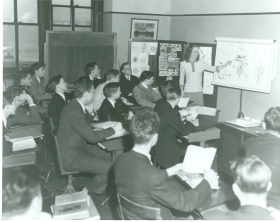Lesson Plan: Oral History
 /tiles/non-collection/e/ed_lesson_plans_page_class_lc.xml
Image courtesy of the Library of Congress
Capitol Pages attending biology class, 1948.
/tiles/non-collection/e/ed_lesson_plans_page_class_lc.xml
Image courtesy of the Library of Congress
Capitol Pages attending biology class, 1948.
Lesson Plan
House History Comes Alive (PDF)
In this lesson, students have the opportunity to learn more about the House of Representatives through the firsthand recollections of longtime employees, Pages, eyewitnesses to historic events, and family of former Members intimately connected to the institution.
Teaching Tips
- Design an online scavenger hunt where students review transcripts, audio clips, video clips, photographs, and artifacts to locate a series of objects and/or places connected to the Capitol (Speaker’s Lobby; cloakroom; electronic voting machine; Little Congress membership card; and the Speaker’s Rostrum, for example).
- Take a series of photographs of your students during the course of a normal day. Then take some photographs of a special event involving the students. Design an activity in which students imagine how historians 30 years from now would describe the pictures and how these photographs could one day be part of an oral history project.
- Have students create a historical timeline with at least eight events based on the oral histories featured on the Web site.
- Have students conduct an oral history with a retired employee that worked in local or state government. Ask students to compare and contrast the experiences of their interviewee with the former House employees featured on the Web site.
- Choose one oral history from the Web site and have students compose five questions that were not asked by the interviewer. Set up a role-play exercise where students are grouped in pairs and have the chance to ask their questions and devise likely answers.
- Have students list three instances in which technology is discussed in the oral histories from the Web site and then ask students to brainstorm and draft a list of three new inventions that would potentially affect all of society (including Congress) during the next 20 years.
- Have students listen to the audio clips for one of the interviewees on the Web site. Ask students to draw or create a visual depiction of what was described in each of the clips.
- Ask students to select three oral histories from the Web site. Based on the job descriptions and recollections provided by each of the interviewees, draft three “Help Wanted” postings. Make sure that each of the postings fit the job requirements for the period in which the person was employed by the House.
- Have students choose one oral history and write a newspaper article (500 words in length) which focuses on the career highlights of the person featured in the interview.
- Ask students to select a historical event like the Depression, World War II, or Watergate and have students locate segments of the oral histories that relate to the given topic. Organize a class discussion about how these people were personally affected by the events.


